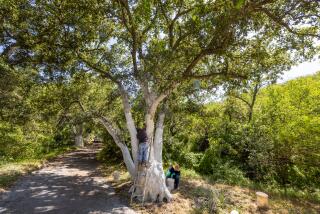Don’t Make a Home for ‘Killer Bees’
- Share via
Question: I heard that “killer bees” have become a menace in Orange County. What should I do to protect my family?
C.R., Fountain Valley
Answer: Africanized honeybees establish colonies in small cavities and protected areas that would not ordinarily be used by domesticated European honeybees, so their nests may be encountered in unexpected places.
Colonies have been found in holes in trees, the space between the walls or buildings, underneath foundations, in sheds, in drain pipes, water-meter valve boxes, abandoned appliances, holes in the ground, piles of junk, flower pots stored upside down, piles of rocks, underneath picnic tables and even in old tires.
In wild areas, there may be as many as 10 to 20 colonies per square mile.
To avoid unpleasant encounters, prevent the establishment of colonies near your house or garden. Fill in cracks and crevices around your house with steel wool or caulk. Cover openings greater than an eighth-inch in walls and chimneys by installing eighth-inch screens. Also cover drain-pipe openings with screen.
Remove junk, rock piles and wood piles. Fill holes in the ground and in water-meter valve boxes. Secure doors to outside utility closets and sheds.
Be on the lookout for unusual bee signs. Watch for bees coming and going from a crack or a hole, and listen for a loud buzzing sound that may indicate the presence of a colony.
Examine areas where you plan to use power equipment and inspect the area around campsites and picnic tables. Stay aware of your environment when hiking.
Often, but not always, serious stinging incidents start with provocation such as a stone tossed at a colony, the vibration of power equipment or attempts to spray bees with water, an aerosol insecticide or other chemicals. Don’t try it, and teach your children not to try it.
When walking, keep pets on a leash so they do not accidentally come upon a colony.
If you discover a bee swarm or believe you have discovered a colony, stay away from it. According to entomologist Nick Nisson with the California State Agricultural Commission, there are no public agencies in Orange County that remove bee swarms or colonies from private property. If you require bee removal, you’ll need to contact a commercial beekeeper or pest-control company.
In other counties, public assistance may be available through vector-control authorities. Los Angeles County has an Africanized honeybee emergency line at (800) 233-9279.
What should you do if, in spite of precautions, you encounter angry bees?
Bees frequently engage in defensive behavior before commencing an attack.
If attacked, don’t flail at the bees. You will only leave yourself unprotected and further anger the bees. Don’t try to fool the bees by standing still. Stings to the chest, back, stomach, arms and hands are less serious than stings to the face and head, so cover them or use your hands and arms to protect your face and head.
Try to get indoors as quickly as possible. If you are far from shelter try running through brush to confuse and slow the bees. Jumping into water is not recommended because Africanized bees will wait in the area for a considerable time.
If you cannot find shelter, you may have to run a quarter-mile or more before the bees stop their attack.
Any person or animal who is not capable of sustained rapid movement is at serious risk once an attack begins. If you see someone else being attacked, call 911 immediately.
If you are stung, evaluate your situation once you are in a safe place.
Treatment of stings by Africanized bees is the same as for those of European bees and wasps. When removing stingers, speed is important. Try to avoid using tweezers or fingers to pull-out stingers as this may squeeze more venom into your wounds.
Bee stingers should be removed by scraping sideways using fingernails, the edge of a credit card or a knife. However, if none of these items are readily available, pulling them out quickly is more important than how you do it. Once stingers are removed, wash the stung area and apply ice packs to reduce swelling. Ordinarily healthy people who are not allergic to bee stings do not die unless they have been stung hundreds of times. Elderly people and children are more at risk and may die from fewer stings.
If you have been stung 15 times or more, if you are allergic to bee stings or if you are having symptoms such as shortness of breath, swelling of the tongue, hives or dizziness, call 911 or seek medical attention immediately.
--Written and researched by University of California master gardener-in-training Harold Pope of Irvine.
Have a problem in your yard? University of California Cooperative Extension (UCCE) master gardeners are here to help. You can reach the hotline at (714) 708-1646 or send e-mail to ucmastergardeners@yahoo.com.






